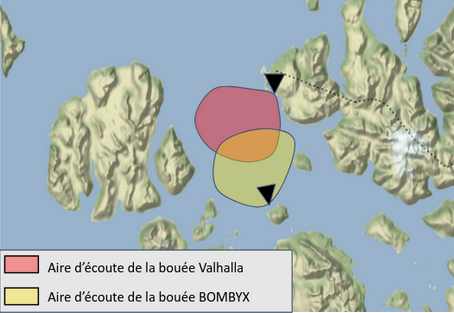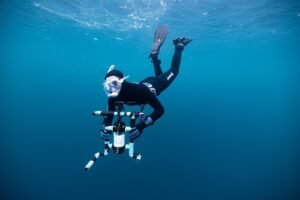ValhallaB
The orcas of Norway, as well as all orcas around the world, are animals that live in highly organized and hierarchical family groups.
To coordinate, socialize, and hunt, orcas use sound on a daily basis. In Norway, where the water is cold and turbid, exchanging visual information is difficult, leaving sound as the primary means of communication, which orcas have mastered.
Orcas can emit different types of sounds: whistles, calls, and clicks. Clicks are very short impulses, like very fast clicks, and their function is to locate prey, their fellow orcas, and their environment – this is echolocation.
The animal emits a sound and then listens to its echo, allowing orcas to navigate and hunt.


The other types of signals emitted by orcas are whistles and calls, which are much longer and contain a lot of information, primarily used for communication.
North of Tromso, orcas feed on herring and have developed a particular hunting technique: they group the herring to form a very compact ball and then rush into the mass of fish.
With a violent tail slap, they stun the herring, making it easy to eat the stunned fish. Many sounds are produced during these hunts, and these collaborative hunting scenes have never been recorded before.
In 2021 and 2022, the Valhalla team was joined by scientists from the University of Toulon, specializing in underwater bioacoustics, who brought acoustic equipment to record the animals. Two protocols were established.
The first acoustic protocol was set up in November 2022. In collaboration with the Valhalla team, the scientists installed a stereo antenna (2 hydrophones) in front of the whale house, at a depth of -7m.

This antenna recorded the sound ecosystem for 4 months, 24/7. This listening protocol will enable the scientists to know the evolution of the orcas’ presence in the Seglvik Fjord, as well as that of the humpback whales.
The University of Toulon’s AI algorithms will automatically detect the calls in the recordings.
© Granzotto
For the second protocol, two acoustic antennas were used, each composed of 5 hydrophones. The antennas were also equipped with onboard cameras. The objective of this protocol was to film and record the animals during hunting periods.
During these scenes, a cacophony of acoustic emissions is present: whistles, clicks, boat noises, and it is impossible to identify the source of the emitted sound.
However, thanks to their acoustic antenna composed of several hydrophones, the scientists could attribute a call or click to a specific individual.
They could be able to understand the true acoustic organization that exists within these hunting scenes, whether there is a leader directing the group or if all animals participate equally in the hunt.
They can also look for individual signatures present in certain species of dolphins.
For the past 10 years, probably due to climate change, a population of humpback whales has changed their migratory strategy to feed in the Arctic during winter instead of migrating to the tropics like others.
These whales have adapted to a new feeding strategy and also feed on herring in Norwegian fjords during winter, putting them in direct competition with orcas.
Acoustic recordings can help scientists understand the interaction between these two species.
Therefore, the scientists go into the water amidst the orcas, humpback whales, and herring, remaining at a reasonable distance so as not to disturb them, and record these magical and rare sounds to uncover the mystery of animal communication.
The two acoustic protocols are complementary and developed in collaboration with the University of Toulon and Valhallab.






